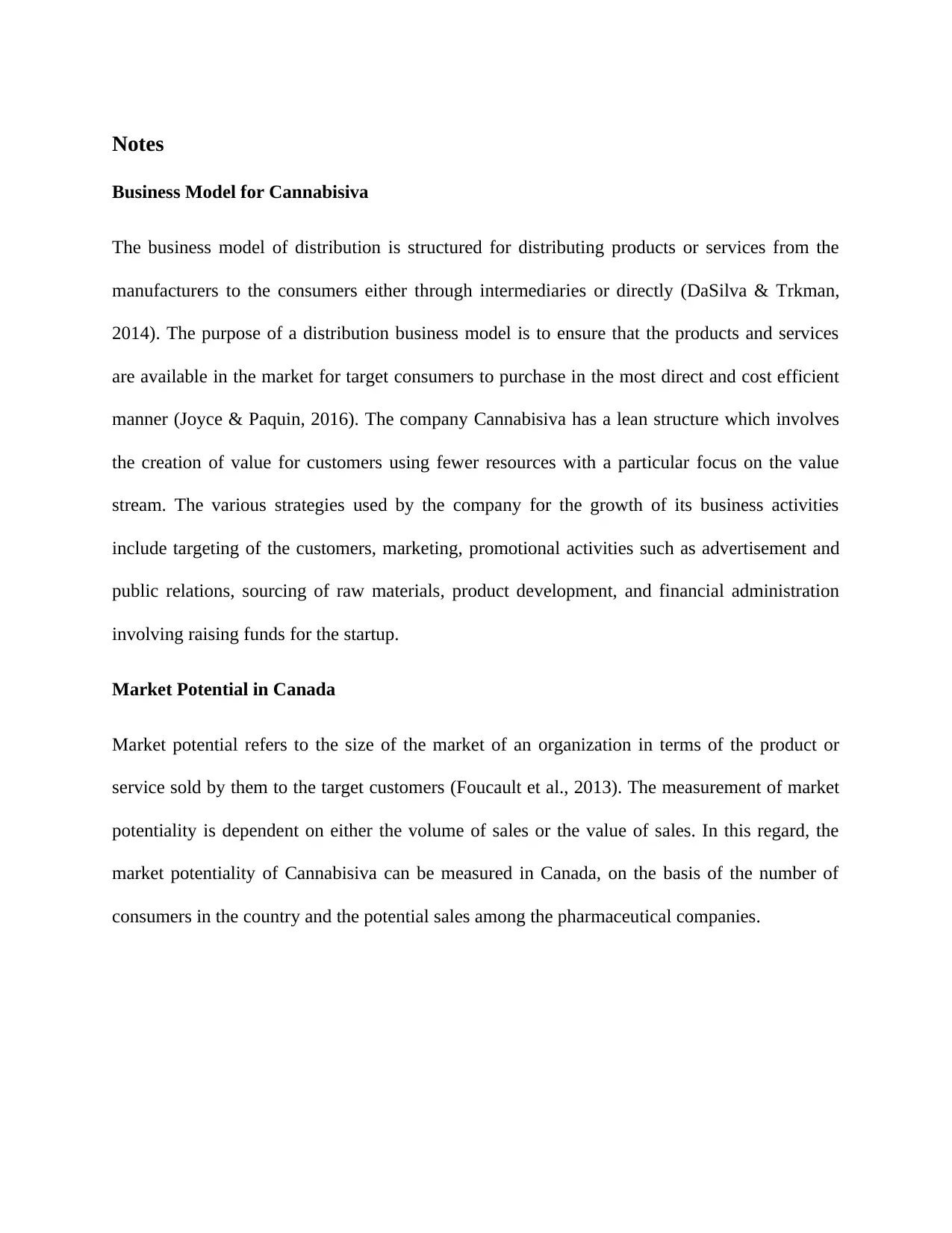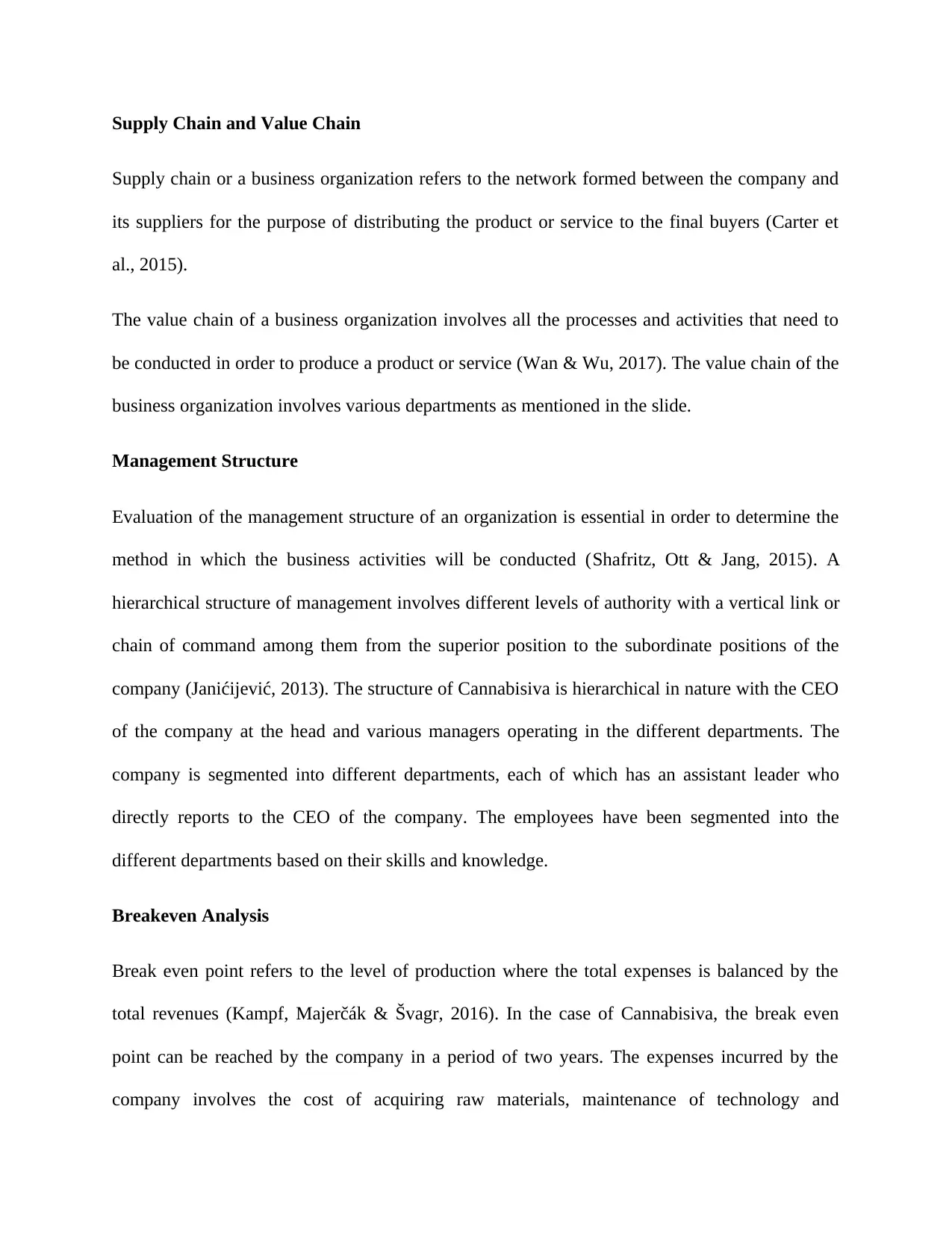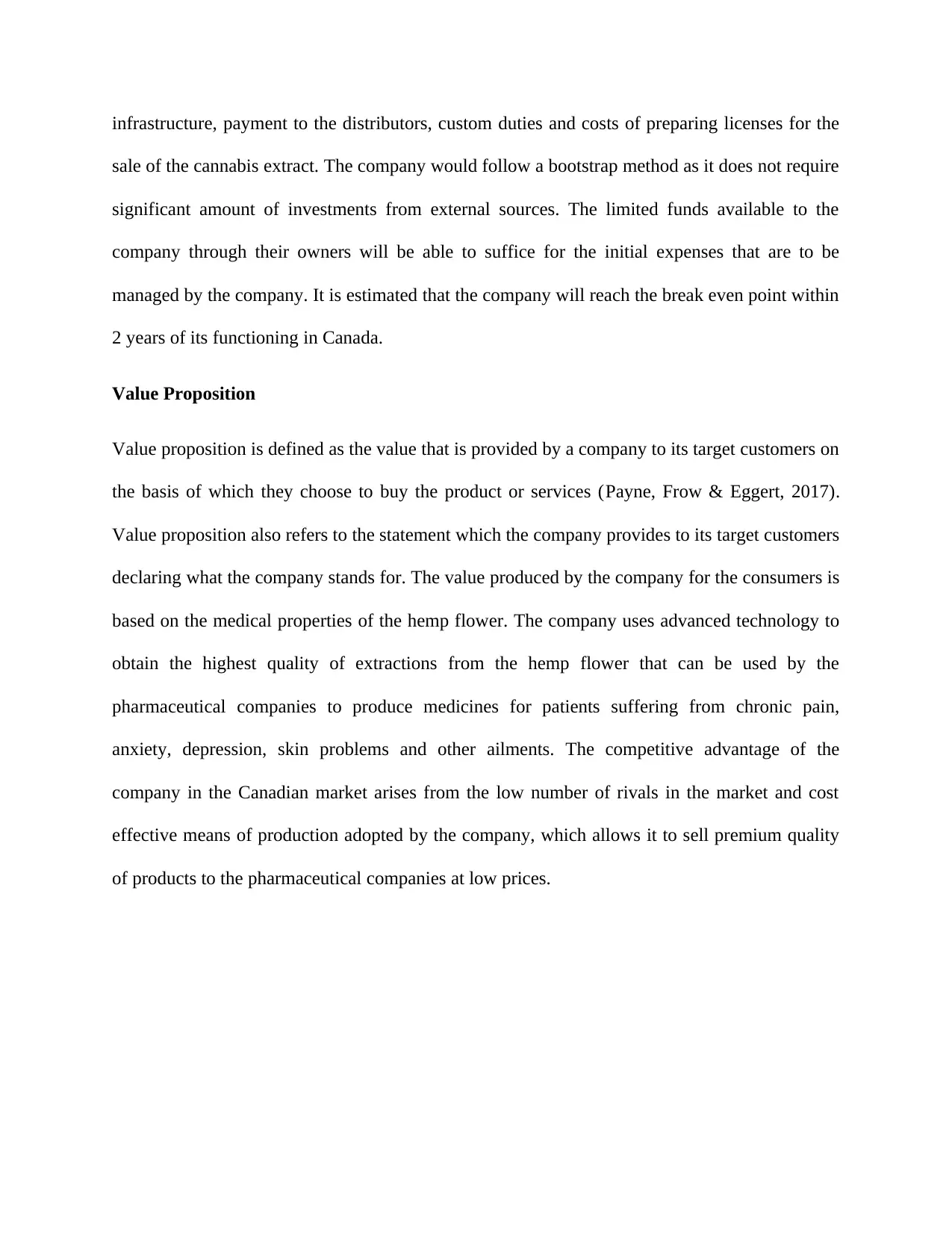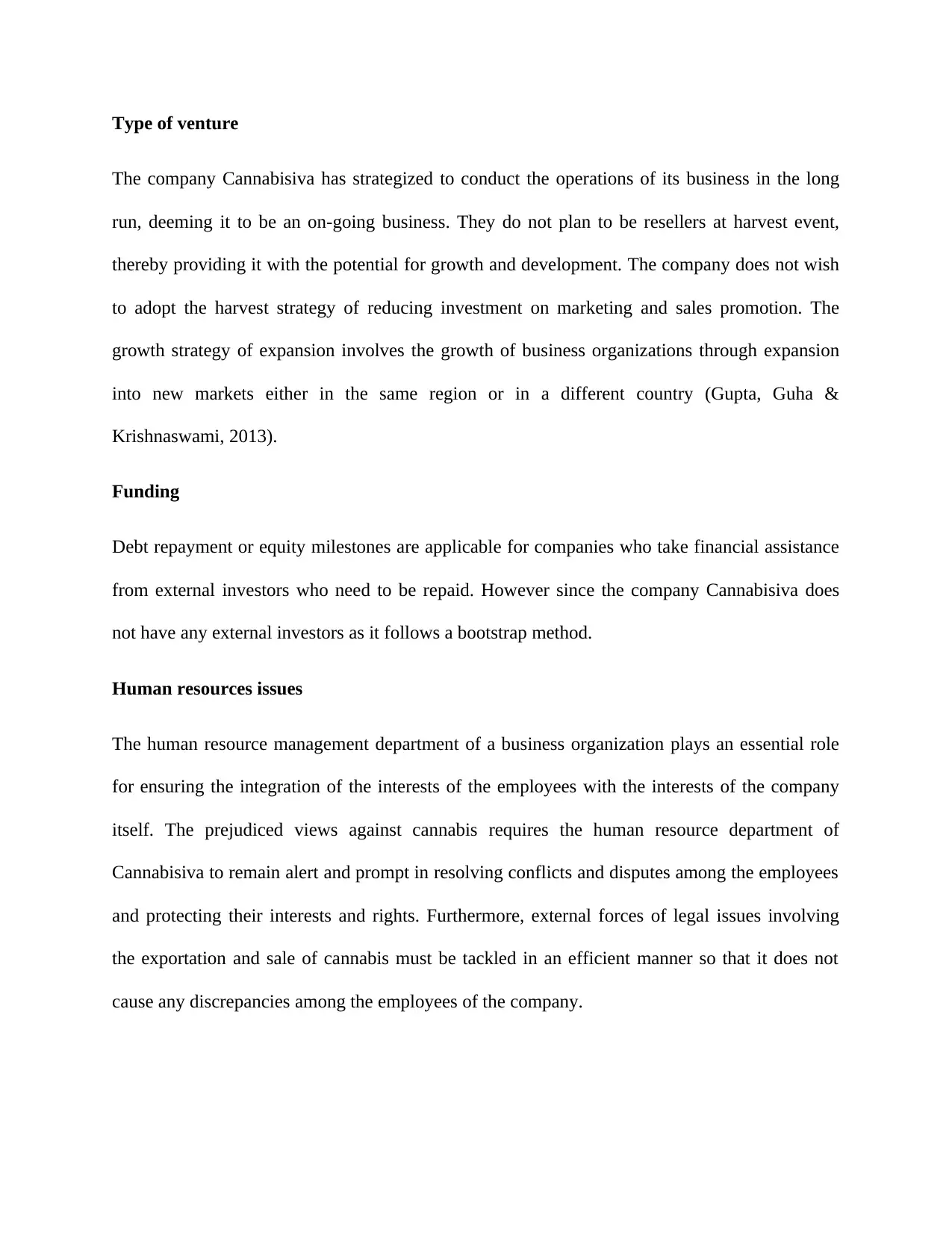Cannabisiva: Comprehensive Business Model Report and Analysis
VerifiedAdded on 2022/08/17
|5
|1065
|11
Report
AI Summary
This report provides a detailed analysis of the Cannabisiva business model, focusing on its distribution strategies, market potential in Canada, and supply chain and value chain dynamics. It examines the company's hierarchical management structure, breakeven analysis, and value proposition based on the medical properties of hemp flower. The report also discusses the company's venture type as an ongoing business, funding through bootstrapping, and human resource considerations, including legal issues related to cannabis. The competitive advantage of the company arises from the low number of rivals in the market and cost effective means of production adopted by the company, which allows it to sell premium quality of products to the pharmaceutical companies at low prices.

Notes
Business Model for Cannabisiva
The business model of distribution is structured for distributing products or services from the
manufacturers to the consumers either through intermediaries or directly (DaSilva & Trkman,
2014). The purpose of a distribution business model is to ensure that the products and services
are available in the market for target consumers to purchase in the most direct and cost efficient
manner (Joyce & Paquin, 2016). The company Cannabisiva has a lean structure which involves
the creation of value for customers using fewer resources with a particular focus on the value
stream. The various strategies used by the company for the growth of its business activities
include targeting of the customers, marketing, promotional activities such as advertisement and
public relations, sourcing of raw materials, product development, and financial administration
involving raising funds for the startup.
Market Potential in Canada
Market potential refers to the size of the market of an organization in terms of the product or
service sold by them to the target customers (Foucault et al., 2013). The measurement of market
potentiality is dependent on either the volume of sales or the value of sales. In this regard, the
market potentiality of Cannabisiva can be measured in Canada, on the basis of the number of
consumers in the country and the potential sales among the pharmaceutical companies.
Business Model for Cannabisiva
The business model of distribution is structured for distributing products or services from the
manufacturers to the consumers either through intermediaries or directly (DaSilva & Trkman,
2014). The purpose of a distribution business model is to ensure that the products and services
are available in the market for target consumers to purchase in the most direct and cost efficient
manner (Joyce & Paquin, 2016). The company Cannabisiva has a lean structure which involves
the creation of value for customers using fewer resources with a particular focus on the value
stream. The various strategies used by the company for the growth of its business activities
include targeting of the customers, marketing, promotional activities such as advertisement and
public relations, sourcing of raw materials, product development, and financial administration
involving raising funds for the startup.
Market Potential in Canada
Market potential refers to the size of the market of an organization in terms of the product or
service sold by them to the target customers (Foucault et al., 2013). The measurement of market
potentiality is dependent on either the volume of sales or the value of sales. In this regard, the
market potentiality of Cannabisiva can be measured in Canada, on the basis of the number of
consumers in the country and the potential sales among the pharmaceutical companies.
Paraphrase This Document
Need a fresh take? Get an instant paraphrase of this document with our AI Paraphraser

Supply Chain and Value Chain
Supply chain or a business organization refers to the network formed between the company and
its suppliers for the purpose of distributing the product or service to the final buyers (Carter et
al., 2015).
The value chain of a business organization involves all the processes and activities that need to
be conducted in order to produce a product or service (Wan & Wu, 2017). The value chain of the
business organization involves various departments as mentioned in the slide.
Management Structure
Evaluation of the management structure of an organization is essential in order to determine the
method in which the business activities will be conducted (Shafritz, Ott & Jang, 2015). A
hierarchical structure of management involves different levels of authority with a vertical link or
chain of command among them from the superior position to the subordinate positions of the
company (Janićijević, 2013). The structure of Cannabisiva is hierarchical in nature with the CEO
of the company at the head and various managers operating in the different departments. The
company is segmented into different departments, each of which has an assistant leader who
directly reports to the CEO of the company. The employees have been segmented into the
different departments based on their skills and knowledge.
Breakeven Analysis
Break even point refers to the level of production where the total expenses is balanced by the
total revenues (Kampf, Majerčák & Švagr, 2016). In the case of Cannabisiva, the break even
point can be reached by the company in a period of two years. The expenses incurred by the
company involves the cost of acquiring raw materials, maintenance of technology and
Supply chain or a business organization refers to the network formed between the company and
its suppliers for the purpose of distributing the product or service to the final buyers (Carter et
al., 2015).
The value chain of a business organization involves all the processes and activities that need to
be conducted in order to produce a product or service (Wan & Wu, 2017). The value chain of the
business organization involves various departments as mentioned in the slide.
Management Structure
Evaluation of the management structure of an organization is essential in order to determine the
method in which the business activities will be conducted (Shafritz, Ott & Jang, 2015). A
hierarchical structure of management involves different levels of authority with a vertical link or
chain of command among them from the superior position to the subordinate positions of the
company (Janićijević, 2013). The structure of Cannabisiva is hierarchical in nature with the CEO
of the company at the head and various managers operating in the different departments. The
company is segmented into different departments, each of which has an assistant leader who
directly reports to the CEO of the company. The employees have been segmented into the
different departments based on their skills and knowledge.
Breakeven Analysis
Break even point refers to the level of production where the total expenses is balanced by the
total revenues (Kampf, Majerčák & Švagr, 2016). In the case of Cannabisiva, the break even
point can be reached by the company in a period of two years. The expenses incurred by the
company involves the cost of acquiring raw materials, maintenance of technology and

infrastructure, payment to the distributors, custom duties and costs of preparing licenses for the
sale of the cannabis extract. The company would follow a bootstrap method as it does not require
significant amount of investments from external sources. The limited funds available to the
company through their owners will be able to suffice for the initial expenses that are to be
managed by the company. It is estimated that the company will reach the break even point within
2 years of its functioning in Canada.
Value Proposition
Value proposition is defined as the value that is provided by a company to its target customers on
the basis of which they choose to buy the product or services (Payne, Frow & Eggert, 2017).
Value proposition also refers to the statement which the company provides to its target customers
declaring what the company stands for. The value produced by the company for the consumers is
based on the medical properties of the hemp flower. The company uses advanced technology to
obtain the highest quality of extractions from the hemp flower that can be used by the
pharmaceutical companies to produce medicines for patients suffering from chronic pain,
anxiety, depression, skin problems and other ailments. The competitive advantage of the
company in the Canadian market arises from the low number of rivals in the market and cost
effective means of production adopted by the company, which allows it to sell premium quality
of products to the pharmaceutical companies at low prices.
sale of the cannabis extract. The company would follow a bootstrap method as it does not require
significant amount of investments from external sources. The limited funds available to the
company through their owners will be able to suffice for the initial expenses that are to be
managed by the company. It is estimated that the company will reach the break even point within
2 years of its functioning in Canada.
Value Proposition
Value proposition is defined as the value that is provided by a company to its target customers on
the basis of which they choose to buy the product or services (Payne, Frow & Eggert, 2017).
Value proposition also refers to the statement which the company provides to its target customers
declaring what the company stands for. The value produced by the company for the consumers is
based on the medical properties of the hemp flower. The company uses advanced technology to
obtain the highest quality of extractions from the hemp flower that can be used by the
pharmaceutical companies to produce medicines for patients suffering from chronic pain,
anxiety, depression, skin problems and other ailments. The competitive advantage of the
company in the Canadian market arises from the low number of rivals in the market and cost
effective means of production adopted by the company, which allows it to sell premium quality
of products to the pharmaceutical companies at low prices.
⊘ This is a preview!⊘
Do you want full access?
Subscribe today to unlock all pages.

Trusted by 1+ million students worldwide

Type of venture
The company Cannabisiva has strategized to conduct the operations of its business in the long
run, deeming it to be an on-going business. They do not plan to be resellers at harvest event,
thereby providing it with the potential for growth and development. The company does not wish
to adopt the harvest strategy of reducing investment on marketing and sales promotion. The
growth strategy of expansion involves the growth of business organizations through expansion
into new markets either in the same region or in a different country (Gupta, Guha &
Krishnaswami, 2013).
Funding
Debt repayment or equity milestones are applicable for companies who take financial assistance
from external investors who need to be repaid. However since the company Cannabisiva does
not have any external investors as it follows a bootstrap method.
Human resources issues
The human resource management department of a business organization plays an essential role
for ensuring the integration of the interests of the employees with the interests of the company
itself. The prejudiced views against cannabis requires the human resource department of
Cannabisiva to remain alert and prompt in resolving conflicts and disputes among the employees
and protecting their interests and rights. Furthermore, external forces of legal issues involving
the exportation and sale of cannabis must be tackled in an efficient manner so that it does not
cause any discrepancies among the employees of the company.
The company Cannabisiva has strategized to conduct the operations of its business in the long
run, deeming it to be an on-going business. They do not plan to be resellers at harvest event,
thereby providing it with the potential for growth and development. The company does not wish
to adopt the harvest strategy of reducing investment on marketing and sales promotion. The
growth strategy of expansion involves the growth of business organizations through expansion
into new markets either in the same region or in a different country (Gupta, Guha &
Krishnaswami, 2013).
Funding
Debt repayment or equity milestones are applicable for companies who take financial assistance
from external investors who need to be repaid. However since the company Cannabisiva does
not have any external investors as it follows a bootstrap method.
Human resources issues
The human resource management department of a business organization plays an essential role
for ensuring the integration of the interests of the employees with the interests of the company
itself. The prejudiced views against cannabis requires the human resource department of
Cannabisiva to remain alert and prompt in resolving conflicts and disputes among the employees
and protecting their interests and rights. Furthermore, external forces of legal issues involving
the exportation and sale of cannabis must be tackled in an efficient manner so that it does not
cause any discrepancies among the employees of the company.
Paraphrase This Document
Need a fresh take? Get an instant paraphrase of this document with our AI Paraphraser

1 out of 5
Related Documents
Your All-in-One AI-Powered Toolkit for Academic Success.
+13062052269
info@desklib.com
Available 24*7 on WhatsApp / Email
![[object Object]](/_next/static/media/star-bottom.7253800d.svg)
Unlock your academic potential
Copyright © 2020–2025 A2Z Services. All Rights Reserved. Developed and managed by ZUCOL.





